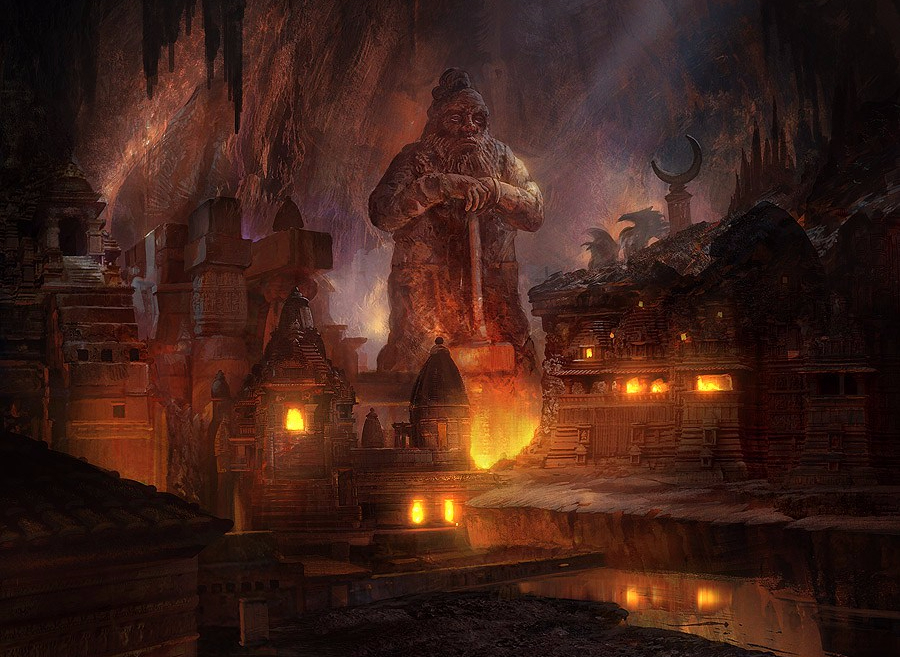"That's what most people don't understand, obviously dwarves is wealthy, but people think that the Underkingdoms are perfect lands uh milk an honey. They's got their poor and rich too, only their poor are rich, and their rich ar'even richer. That's why that dwarf there came here see! In his land he was probably some half-paid pauper, mining shite outta the dirt, only now he moves here to White Veil, and he'in went'in got'imself the 3rd biggest house in the town, and has some land out there with peasants working it and all that. Now, can you imagine how poor we'd be if we went to where he came from?"
-Famous Beggar, Ernie Two-Eyed
The Cultures of the Seven Underkingdoms
The Seven Underkingdoms, or rather now, the six underkingdoms, are the pinnacle of civilization in Adra. They have rivals, in the elves of the north and south, and the Gamorans, but for sheer power, wealth, and an ability to control their lands, no civilization reaches the peak that dwarvish civilization has reached. The dwarves were the first kith to inhabit the world, created by their Stone God Oerack, and in their early days they would cling to the mountain ranges of Adra to avoid annihilation from the horrific monsters that roamed the world at that time. They dug into these mountains, pulling ore from the ground and developing magnificent skill for forgecraft and stonework. And as the ages ground their opponents into the dust, the dwarves held on, digging ever deeper, and ever wider, until they had founded seven underkingdoms, that is seven cities that are entirely (or almost entirely) under the ground, and often spanning miles with sprawling complexes, towering halls, and thousands of chambers. These Underkingdoms would pull in uncountable fortunes in precious metals and rare gems, which made the dwarves unfathomably rich. Indeed, even a poor dwarf often has more money than a somewhat well-off human. The dwarves traded these gems and metals for food, lumber, animals, clothing, and anything else which they termed too menial to produce themselves. The trade encouraged human communities to flourish in the shadow of these underkingdoms: some dwarves used these communities, but kept them at arms length, while others became benevolent lords of them, sending troops to protect them and establishing embassies to facilitate further trade. These underkingdoms were not city states either, spreading colonies across the mountain ranges they inhabited, and building forts to protect vulnerable points in their kingdoms. Prosperity flourished, and across the Seven Kingdoms, a golden age reigned.
That golden age is now a generation or two passed. The sacred homeland of all dwarf-kind, Drumshiel, was besieged, sacked, and destroyed, casting its survivors to the winds. This created a havoc in the trade routes of the Underdark, and the chaos gave Duergar and all manner of foul beasts the opportunity to raid dwarven trade and encroach on dwarven fortresses. Meanwhile, the Dwarves of the Firebrand Mountains prepare for an all-out-war with Valentera, of which the result remains very much in doubt. It is largely believed by the dwarves of Vulkaris that a loss in the war would mean a genocidal purge of their entire underkingdom. Still, darkness is not all that remains, as dwarves from across the other five kingdoms, and the many independent clans as well, flock to Vulkaris to grant them their support, either militarily or economically. And while times are bleak for the people of Drumshiel, there remains hope, and all that is needed is one of Usgaroth's line to take up the call to arms. The Golden Age of the Dwarves is at an end. The Iron Age has just begun.
The reason that dwarves are grouped into their own culture group, as opposed to falling where they would geographically, is because dwarves have done very well at maintaining a larger united culture over the centuries. The sheer age of their race, their use of underdark passages to connect their disparate kingdoms, and their obsessive record keeping on stone tablets has all allowed them to maintain a united culture group that defied geographical boundaries. The most common races found in the Seven Underkingdoms are obviously the dwarves. However, hosts of humans and other races often live under the protection of some of these nations, and in rare cases, outsiders are allowed to live in the Underkingdom proper. You might want your character's culture to be of the Seven Underkingdoms if they enjoy industrious labor, seek plunder in the depths of the world, find warfare to be relaxing, seek to protect weaker races, or, most importantly, are a dwarf. This is of course very broad-strokes, and you should have a look at the following cultures to learn more about the subtleties of each:
Broagan Culture: The dwarves of the Wretched Spine Mountains, paranoid of outsiders and wary of relying on trade.
Brunian Culture: The dwarves of the northern Roughcut Mountains, who remain beneath the ground longer than all of their kin.
Canaen Culture: The dwarves of the Wandering Mountains, the most welcoming and warm to outsiders.
Hillen Culture: The dwarves of the hills of Malmuir, the most peace loving and least ambitious of their kin.
Marian Culture: The dwarves of the southern Roughcut Mountains, the only dwarves known for sea-born trade.
Shielan Culture: The diaspora of dwarves originating from Drumshiel and the Usgaroth Mountains, spread across the world.
Vulkish Culture: The dwarves of the Firebrand Mountains, the most martial and warlike of their kin.
Back to Culture
Back to Expanded Backgrounds
Back to Adra - 3rd Era World Guide

